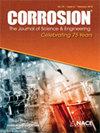裂纹萌生特征对敏化AA5456-H116在海洋环境中环境辅助开裂行为的影响
IF 1.3
4区 材料科学
Q4 MATERIALS SCIENCE, MULTIDISCIPLINARY
引用次数: 0
摘要
通过基于断裂力学的测试,评估了裂纹萌生特征对敏化AA5456-H116暴露于海洋环境中的环境辅助开裂(EAC)行为的影响。将含有传统疲劳预裂纹或有意引入晶间腐蚀裂纹的试样浸入0.6M NaCl中,并在恒定力下极化以选择电化学电势。这些实验测得的裂纹长度与时间的关系表明,两种试样几何形状在-900mVSCE下和在-800mVSCE下开始加速裂纹扩展后产生相似的裂纹增长率。然而,由于实验开始时裂纹增长率增加,预腐蚀试样在-800mVSCE下的失效时间明显短于预裂纹试样。使用EAC的广义模型来确定可能导致预腐蚀试样的EAC易感性最初增加的机械、环境和材料因素。对这些可能的原因因素的分析表明,磁化率的增加是由于用于加速裂纹生长的侵蚀性恒流极化在闭塞的腐蚀裂隙尖端产生了残余的、最初更有害的裂纹化学物质。讨论了这些结果对基于传统断裂力学的EAC易感性量化方法的有效性的影响。本文章由计算机程序翻译,如有差异,请以英文原文为准。
The effect of crack-initiating feature on the environment-assisted cracking behavior of sensitized AA5456-H116 in marine environments
The influence of crack-initiating feature on the environment-assisted cracking (EAC) behavior of sensitized AA5456-H116 exposed to marine environments is assessed via fracture mechanics-based testing. Specimens that contained either a traditional fatigue precrack or purposefully introduced intergranular corrosion fissures were immersed in 0.6 M NaCl and polarized to select electrochemical potentials while held at a constant force. The measured crack length versus time relationships from these experiments reveal that the two specimen geometries yield similar crack growth rates at -900 mVSCE and after the onset of accelerated crack propagation at -800 mVSCE. However, precorroded specimens exhibit significantly shorter times to failure than the precracked specimens at -800 mVSCE due to increased crack growth rates at the start of the experiment. The mechanical, environmental, and material factors that could contribute to the initially increased EAC susceptibility of the precorroded specimens are identified using a generalized model for EAC. Analysis of these possible causal factors suggests that the increased susceptibility is due to a residual, initially more deleterious crack chemistry at the occluded corrosion fissure tip from the aggressive galvanostatic polarizations used to accelerate fissure growth. The implications of these results on the efficacy of traditional fracture mechanics-based methods for quantifying EAC susceptibility are discussed.
求助全文
通过发布文献求助,成功后即可免费获取论文全文。
去求助
来源期刊

Corrosion
MATERIALS SCIENCE, MULTIDISCIPLINARY-METALLURGY & METALLURGICAL ENGINEERING
CiteScore
2.80
自引率
12.50%
发文量
97
审稿时长
3 months
期刊介绍:
CORROSION is the premier research journal featuring peer-reviewed technical articles from the world’s top researchers and provides a permanent record of progress in the science and technology of corrosion prevention and control. The scope of the journal includes the latest developments in areas of corrosion metallurgy, mechanisms, predictors, cracking (sulfide stress, stress corrosion, hydrogen-induced), passivation, and CO2 corrosion.
70+ years and over 7,100 peer-reviewed articles with advances in corrosion science and engineering have been published in CORROSION. The journal publishes seven article types – original articles, invited critical reviews, technical notes, corrosion communications fast-tracked for rapid publication, special research topic issues, research letters of yearly annual conference student poster sessions, and scientific investigations of field corrosion processes. CORROSION, the Journal of Science and Engineering, serves as an important communication platform for academics, researchers, technical libraries, and universities.
Articles considered for CORROSION should have significant permanent value and should accomplish at least one of the following objectives:
• Contribute awareness of corrosion phenomena,
• Advance understanding of fundamental process, and/or
• Further the knowledge of techniques and practices used to reduce corrosion.
 求助内容:
求助内容: 应助结果提醒方式:
应助结果提醒方式:


